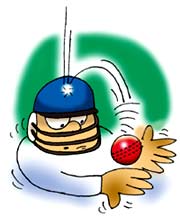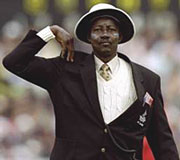 Home > Cricket > Diary archives
Home > Cricket > Diary archivesSeptember 10, 2001
The umpire strikes back
Prem PanickerHello all at the start of another working week -- and this is one time where all I need to do is play amanuensis.
Earlier this month, we'd done this diary on some of the ICC's new rules.
One of the responses comes from Rampriya, a 34-year-old umpire in good standing with the KSCA -- and his take on some of the rules, frankly, had me hunting through the books to read the exact wordings, and finding that the result of that study was much bemusement.
What follows is his mail, edited in parts. Quote:
 1: First, I find the concept of leg byes nauseating. In a game that surely evolved from the concept of a contest between bat and ball, runs off the batsmanís person have been bafflingly allowed for almost 250 years now, and no oneís in a mood to scrap them just yet! For the ultimate good of this game, leg-byes are best gone.
1: First, I find the concept of leg byes nauseating. In a game that surely evolved from the concept of a contest between bat and ball, runs off the batsmanís person have been bafflingly allowed for almost 250 years now, and no oneís in a mood to scrap them just yet! For the ultimate good of this game, leg-byes are best gone.
2: Law 26.2 needs to be reworded to avoid needless embarrassment to unsuspecting umpires. Consider this scenario: A medium-pacer's delivery brushes the batsman's pad as he shapes to defend, then takes the bat's outside edge and goes through to the fence.
The unsuspecting umpire signals four leg-byes -- and a storm begins to rage. The runs, people say, must go to the batsman. In response I say, read the law -- which says that if the ball brushed pad before it touched the bat, then it is leg byes. But the umpire gets trashed anyway. I write to the MCC, asking for a verdict. The MCC apologizes for the "unfortunate" wording of the law, but that is it. The wording remains the same, and with it, the situation.
3: A fielder who's been off the field for 15 minutes or more has to serve a sentence. Everyone knows that, but I am the only one who seems to be in a mood to crib about its ludicrous logic. Consider this: If you are back on the field after 899 seconds, you can bowl immediately. But if you take 900 seconds, you then have to wait for 900 seconds before you can bowl again.
The rule makes little sense. A more sensible one would be to say, you are permitted 15 minutes off. If you take 16, then you have to wait one minute after you return before you can bowl; take 30, and you are out of action for 15 minutes, and so on. In other words, the proper sentence should be only that period beyond the initial permissible concession.
4. If a helmet is permisible as protective equipment for a fielder, then a catch off it should also be allowed. Before you starting arguing with me, remember that if you hit the ball hard and it thuds into the stumps, or the umpire, or even the non-striker, at the opposite end, you can be caught. So why not off a helmet? The funny bit is, if you are caught off the helmet the rule is you are not out, but if you are caught off the shin guard of a fielder, then you are out -- and why? Because the shin guard is defined as "external" protective equipment. Huh? So what's a helmet, some kind of internal device?
5. In ODIs, one batsman can bat the full 50 overs, if he is able -- so why should a bowler alone be limited to bowling just 10 overs? Actually, this rule of no-limits for the bowler has been implemented in the KSCA league for a few years now, and no one has yet complained.
6. Why oh why are wides in Tests different from wides in ODIs? For the life of me, I dont see how a delivery that is out of reach for a batsman in one form of the game is within reach in another form of the game.
 7. Law 18.5 (a)(iii) refers to a batsman running short, and according to it, all runs should be disallowed in case it is done deliberately. If you take the law at its word, then what happens if a batsman strokes a ball, takes off, crosses his partner and, seeing the ball going through to the fence, turns back mid-pitch? If I implement the wording of the law, then that four should be disallowed -- the batsman deliberately ran short, and *all runs* that are taken off that shot should be disallowed, is what it says in the good book.
7. Law 18.5 (a)(iii) refers to a batsman running short, and according to it, all runs should be disallowed in case it is done deliberately. If you take the law at its word, then what happens if a batsman strokes a ball, takes off, crosses his partner and, seeing the ball going through to the fence, turns back mid-pitch? If I implement the wording of the law, then that four should be disallowed -- the batsman deliberately ran short, and *all runs* that are taken off that shot should be disallowed, is what it says in the good book.
Okay, I am citing an extreme case, but even if batsmen deliberately run short and the ball crosses the boundary on its own impetus, the law states that the boundary is to be disallowed.
8. Here's another one of those laws that could do with rethinking, and rephrasing. When the ball is in play, if the bails fall down for some reason (say, breeze), a wicket can be taken if any of the remaining stumps are struck clean out of the ground.
This is illogical. Take a run out situation, where even as the batsman plays the ball, the bails fall down due to a stiff breeze. A fielder gets to the ball, throws at the stumps, the stumps are bent back -- but not entirely uprooted. In such a case, as an umpire, I have to give it not out even if the batsman is well short, because the rule says that if the bails are not on the stumps, then to effect the dismissal, the stump has to be entirely knocked out of the ground.
The funny thing is, that as per the same rule book, if it is windy the umpire is allowed to do away with the bails altogether -- and in that case, if the ball hits the stumps, the umpire's discretion decides if it is out or no, the stumps don't have to be uprooted to effect the dismissal. Which makes sense, how?
Close Quote
And over to all of you out there. Is this why they say the law's an ass?
Also read:
Selection trial
The Rediff Email Diary -- the complete archives
![]()
![]()
Email : Prem Panicker
![]() Illustration: Uttam Ghosh
Illustration: Uttam Ghosh
©1996 to 2001 rediff.com India Limited. All Rights Reserved.